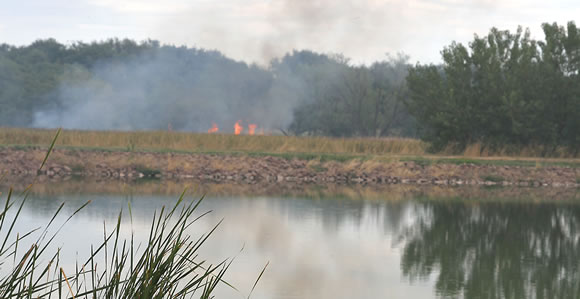
Lake of fire

The Clarendon Enterprise - Spreading the word since 1878.



Seven registered sex offenders who had recently arrived in Clarendon all packed up and left town this week, but an “alternative housing” facility for similar offenders is still in operation.
Donley Count Sheriff Butch Blackburn said the men arrived here in the last two weeks, but they departed Tuesday morning for Houston and El Paso after parole officials discovered a “technical error.”
Blackburn said he didn’t know what the “error” was, but he believed an outcry from the public and citizens’ calls to state officials concerning the men’s presence in this community had something to do with their removal.
“I think that helped more than anything,” Blackburn said. “Putting pressure on the state is the only way to stop this.”
State Sen. Kel Seliger said his office received a call concerned about the facility in Clarendon. His office then notified the state agency of the concern, and the agency took it from there. Seliger said there is a definite need for such facilities in the state but also said he understands the concerns.
“These get located in big towns and small towns,” the senator said.
Seliger said his office often helps make the connection between constituents with concerns and the appropriate agency.
“That’s what we do,” Seliger said. “The people of Donley County are always welcome to call our office.”
Sheriff Blackburn said six of the seven men who left town were among the seven whose names were published in public notices in last week’s Enterprise. The seventh man who left this week just arrived last Thursday. Another man, who has served the entirety of his sentence, will be moving here this week.
“Just because we lost seven doesn’t mean we won’t gain that many more back,” the sheriff said.
Blackburn said his office has received several calls about what is commonly referred to as halfway house operating in the city.
“These facilities are by no means supported by the Donley County Sheriff’s Office or wanted by the sheriff’s office,” Blackburn said. “This was something the state allowed without consideration of the well-being of Donley County or its citizens. We already had plenty of homegrown sex offenders without bringing more in.”
The sheriff says people should be careful about hiring people they don’t know and should keep watch on their kids.
“I’m warning the citizens that we will likely continue to be flooded with these types of people as long as we have this facility operating,” he said.
Blackburn said registered sex offenders have to notify his office within 48 hours of moving to Donley County, and then his office runs a printed notice in the Enterprise as soon as possible. A state-run website listing sex offenders lags up to three weeks in being updated.
The sheriff said currently anyone convicted of a sex crime is supposed to register, but the rules vary some depending on circumstances and some people convicted of sex crimes do not have to register at all based on when they committed their crime.
“We have some folks here just as dangerous as these were, but they committed their crime before it was required to register,” he said.
Blackburn said sex offenders also face different rules depending on whether they are on probation, which carries the most restrictions, are on parole, or have served their sentence entirely.
Last week, social media discussions exploded over concerns about the number of registered sex offenders living in the city after a man reportedly attempted to pick up a local girl. Although it was never proved that it was related, the incident resulted in the public’s attention focusing on a facility, frequently being called a halfway house, in north Clarendon.
Texas Department of Criminal Justice Public Information Officer Robert C. Hurst told the Enterprise that Shekinta Ministries rents to parole clients as it is an Alternate Housing Resource for the client population.
Alternate housing locations, Hurst said, are typically operated by non-profits and religious groups and are a housing option for individuals on supervision.
The difference between a halfway house and alternative housing is that TDCJ does not have a contracts with alternate housing providers, whereas a halfway house is a facility that has a contractual relationship with TDCJ.
“There are no TDCJ contracted facilities in Donley County; however, Shekinta Ministries, 218 N. Sully St, Clarendon, TX. 79226, is an approved alternate housing location that provides residence for up to seven paroled offenders,” Hurst wrote.
Blackburn told the Enterprise that he understands Shekinta is operating three locations here, the one on North Sully Street, another on North Gorst Street, and a third on White Street. Hurst said Tuesday afternoon he could not find any information about state-approved Shekinta facilities other than on Sully Street.
Hurst wrote that facilities such as the one operated by Shekinta have to follow a procedure to be opened. Potential facilities can request placement on the Alternate Housing Resource Listing by completing the application process through the Parole Division. Alternate Housing sites are not TDCJ contracted facilities.
Hurst said TDCJ or other state agencies do not provide funding for these facilities.
So how do offenders find out about Alternative Housing available in a place like Clarendon?
Hurst said clients who have no other viable residential plan options are provided information about approved Alternate Housing Resource locations to assist in plan development.
The Enterprise attempted to contact Shekinta founder and president David A. Hurlbeck for a comment Tuesday afternoon. There was no return call as of press time.
Blackburn, meanwhile, is continuing to oppose Shekinta’s operation here.
“These people are not innocent; they have been convicted of their crimes,” the sheriff said. “This situation is not good for Donley County. We don’t have any local control over it. I appreciate the concerns of our local citizens, and I ask them to continue to let their state leaders know we do not want this and do not need this added chance for crime in our county,” Blackburn said.
Richard Darrell Gaines, 52, of Clarendon died Saturday, August 4, 2018. in Claude.
Memorial Services were be held on Wednesday, August 8, 2018, at 3:00 pm in the First Baptist Church in Clarendon with Elder Jeff Riles, officiating.

Cremation & Arrangements are under the direction of Robertson Funeral Directors of Clarendon.
Richard was born July 20, 1966, in Clarendon to Alton and Billie Ruth Wilson Gaines. He had been a resident of Clarendon most of his life. He was a US Army veteran. He loved football and played semi pro football for few years. Later, he tried out for the Dallas Cowboys. He loved working on computers and fixing computers. He also enjoyed collecting autographs from all sporting events. He was a member of the True Church of God in Christ in Clarendon.
He was preceded in death by his parents; and a brother, Benjamin Gaines.
He leaves to cherish his memory, his son, Richard Duane Gaines and wife Chelsi of Amarillo; his daughter, Rebecca Danielle Gaines and husband Brad Snow of Utah; 5 brothers, Alton Gaines of Clarendon, Johnny Gaines of Amarillo, Danny Gaines of Clarendon, Randy Gaines of Amarillo, and Brent Gaines of Clarendon; a sister, Glenda Wilson of Clarendon; 4 grandchildren, Brooklyn Gaines, Bane Snow, Emma Snow, and Bella Snow; and numerous nieces, nephews, and cousins.
Sign our online guest book at www.RobertsonFuneral.com


A blast of destruction hit Clarendon Sunday night, July 29, when a sudden storm swept through the city unexpectedly.
The Donley County Sheriff’s Office logged the first trouble at 8:12 p.m. when a 911 caller reported the first power outage associated with the storm, the harbinger of what would be a long night for emergency personnel and utility workers.

As winds picked up, driving heavy rain sideways, trees took the brunt of nature’s fury across the city and nearby rural areas. Massive tree limbs were broken off, several inches in diameter in some cases. Some trees were lost entirely, as was the case of an old cedar tree behind the Donley County Courthouse that was guessed to be at least 100 years old. The storm snapped the tree about eight feet off the ground, but it fortunately missed the historic building when it came down.

The greatest damage downtown was inflicted on the abandoned Antro Hotel at First and Kearney. The 1927 three-story hotel was already missing its roof and much of its interior structure from an aborted attempt to demolish the building about 30 years ago. When the straight-line north winds, measured at up to 84 miles per hour, hit the north face of the building, most of the upper two floors of that brick wall collapsed over into the interior of the structure, crashing all the way into the basement.
At the Sandell Drive-In, the storm flattened the marquee of that historic business and peeled the roof off of the concession stand structure, exposing the projection equipment to the elements.
Part of the front of the old Dairy Queen building was blown away; and across the city, residents suffered roof and other damage from the high winds.
Weather officials termed the storm a microburst, and two accidents occurred on US 287 due to the weather, one east of town and the other west of town.
Southwestern Electric Power Co. lines were knocked down and linemen worked throughout the night to restore electric service. The entire town was without power for about three hours with much of the city remaining darkened until after midnight and some people not getting power restored until 4 a.m. or later.
The storm was followed by another, less severe round of rain and wind after midnight. Altogether, the Enterprise gauge measured 0.55 inches of precipitation.
Clean-up will likely continue for several days as residents and local officials work to recover from the event.
For more storm photos, see this week’s Enterprise available online here: http://www.clarendonlive.com/?p=6507
Clarendon’s water recreation project could be open for business next summer following last week’s action by the City Council.
The city recently reviewed proposals from engineering firms for the job, and aldermen reviewed a committee’s scoring of those proposals before voting to select Waters Edge Aquatic Design out of a group of seven applicants.
“This is a historic moment, guys,” Mayor Sandy Skelton told the council before the vote was taken.
Waters Edge has previously done the concept design work for the Clarendon pool project. City Administrator David Dockery said the firm was selected because for its ability to do all the engineering in-house, its record of bringing projects in either at or below budget, and because they felt they could meet the goal of finishing the project to be open next summer.
Waters Edge is also the same firm that designed the Wellington Aquatic Venue.
Dockery said groundbreaking on the $1.9 million water recreation facility is expected to take place in October.
In other city business, the aldermen voted to continue using the Donley County State Bank as the city’s depository.
Aldermen approved applying for a RAMP grant through the Texas Department of Transportation to patch cracks in the airport runway. The project is expected to cost about $34,000, and the grant would pay about fifty percent. The city already has about $14,000 in an account for airport work.
An agreement was signed with Chloe’s Canines to assist the city with adopting out dogs captured by animal control. The agreement calls for the city to pay the animal shelter $500 per year to assist the city.
In his administrator’s report, Dockery complimented the public works department for a recent in-house job that looped some waterlines downtown to improve water pressure to part of the central business district, including the Fire Hall. Dockery said the work should have a positive effect on the city’s key rates for insurance.
Aldermen also reviewed the draft budget and discussed the tax rate for the coming year. The council is proposing a tax rate of $0.75865 per $100 valuation, an increase over the current rate of $0.733821. Dockery said that while this year’s proposed rate is higher, the city will pay off some of indebtedness in 2019 that should in a much lower rate for 2020.
American Electric Power is canceling the Wind Catcher project as a result of the Public Utility Commission of Texas’ July 26 decision to deny approval of the project.
The project had been approved by the Arkansas Public Service Commission, Louisiana Public Service Commission and Federal Energy Regulatory Commission. A decision was pending at the Oklahoma Corporation Commission.
AEP unit Southwestern Electric Power Company’s (SWEPCO) share of the project was 70 percent, and Public Service Company of Oklahoma’s (PSO) share was 30 percent.
“Wind Catcher has had broad support among many customers, community leaders and elected officials, and we greatly appreciate this support,” said Malcolm Smoak, SWEPCO president and chief operating officer. “They embraced the extraordinary opportunity Wind Catcher would provide for long-term savings on electricity costs for families, businesses and communities, as well as more clean energy and a more diversified energy mix.”
“We also appreciate the careful examination and ultimate approval of the project by Arkansas, Louisiana and federal regulators,” Smoak said.
The $4.5 billion Wind Catcher project included acquisition of a 2,000-megawatt wind farm under construction in the Oklahoma Panhandle and construction of an approximately 350-mile dedicated generation tie line to the Tulsa area, where the existing electrical grid would deliver the wind energy to SWEPCO and PSO customers.
“We are disappointed that we will not be able to move forward with Wind Catcher, which was a great opportunity to provide more clean energy, lower electricity costs and a more diverse energy resource mix for our customers in Arkansas, Louisiana, Oklahoma and Texas,” said Nicholas K. Akins, AEP chairman, president and chief executive officer.
“To realize the full benefits of Wind Catcher for customers, timely approvals were required from all jurisdictions so we could complete the project by the end of 2020 and be eligible for 100 percent of the federal production tax credit. We want to thank our employees and our partners for all of their work on the development of the Wind Catcher project,” Akins said. “The strategic investments we are making in AEP’s regulated businesses will continue to support our 5 percent to 7 percent earnings growth rate. We are investing in a cleaner, smarter energy system for our customers and will continue to pursue opportunities to provide the new energy resources and technology solutions that bring value to our customers.”
AEP plans to invest $24 billion in 2018-2021 to rebuild and enhance aging infrastructure, add advanced technologies to the energy system and create a more reliable grid to enhance service for customers.

Reader Comments